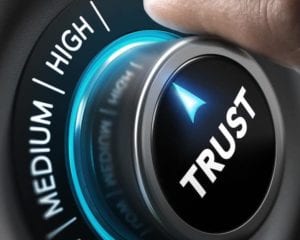What is the Trust Equation?
The Trust Equation
In 2000, Harvard professors David H. Maister, Charles H. Green, and Robert M. Galford published a book called “The Trusted Advisor”. In this book, they discussed research that they had conducted, which examined how businesses go about choosing their legal service providers. In the course of this research, they found that it was actually possible to create a mathematical equation that could accurately represent the factors involved in this decision-making process. The equation created by the professors was as follows:
Credibility + Reliability + Intimacy divided by Self-Orientation = Trust.
The trust equation is a way to measure trustworthiness – how much trust can you place in others and how much trust others place in you.
The elements are as follows: –
-
Credibility
Does the person in front of us actually know their stuff? Has this person the knowledge and experience required to drive the agenda and therefore could we have faith in them?
-
Reliability
Does the person keep their promises, deliver results when they say they will, and keep people informed of what they are up to? All of these add up to a sense that people can rely on them.
-
Intimacy
This is about relationship building. If a person can give cold-hard advice and be reliable, people should trust them. But trust is a human thing, and we make emotional judgments even when emotions ought not matter.
-
Self-Orientation
Where does this person’s focus lie? Do they have my best interests at heart or are they doing this for themselves? Are they really helping me or are they simply doing this to get something out of it?
Calculating Trust
In assessing trustworthiness in a person, calculate a score by grading each element out of ten or use a low, medium and high system. Whichever system works well for you, it will give you an overall idea of the results, how you feel about the results and any action to be taken.
Five-stage process for building trust:
- Engage with the person
- Listen to them – this is more important, by far, than being heard by them.
- Frame their concern in a way that demonstrates you understand the issue at hand.
- Envision what you can accomplish by working together
- Commit to your part in what you both need to do
The importance of trust
Trust in the workplace doesn’t come from authority or job titles. There is evidence that trust is a simple product of gratitude, validation, and understanding. Trust leads to greater efficiency, bonding, and the desire to please, all of which can improve and transform any workplace.
Trust in the workplace has a big impact on how employees collaborate and work together on the same projects. As most employees are still working from home these days, employers have started realising how important it is to build trust.
The Trust Equation provides a scientific, analytical, and actionable framework by which to help organisations and individuals improve their businesses. Trust is the backbone required for good leadership. If you are looking at developing leadership skills for yourself or others within your organisation Tick HR Solutions can help.
The Trust Equation guide


